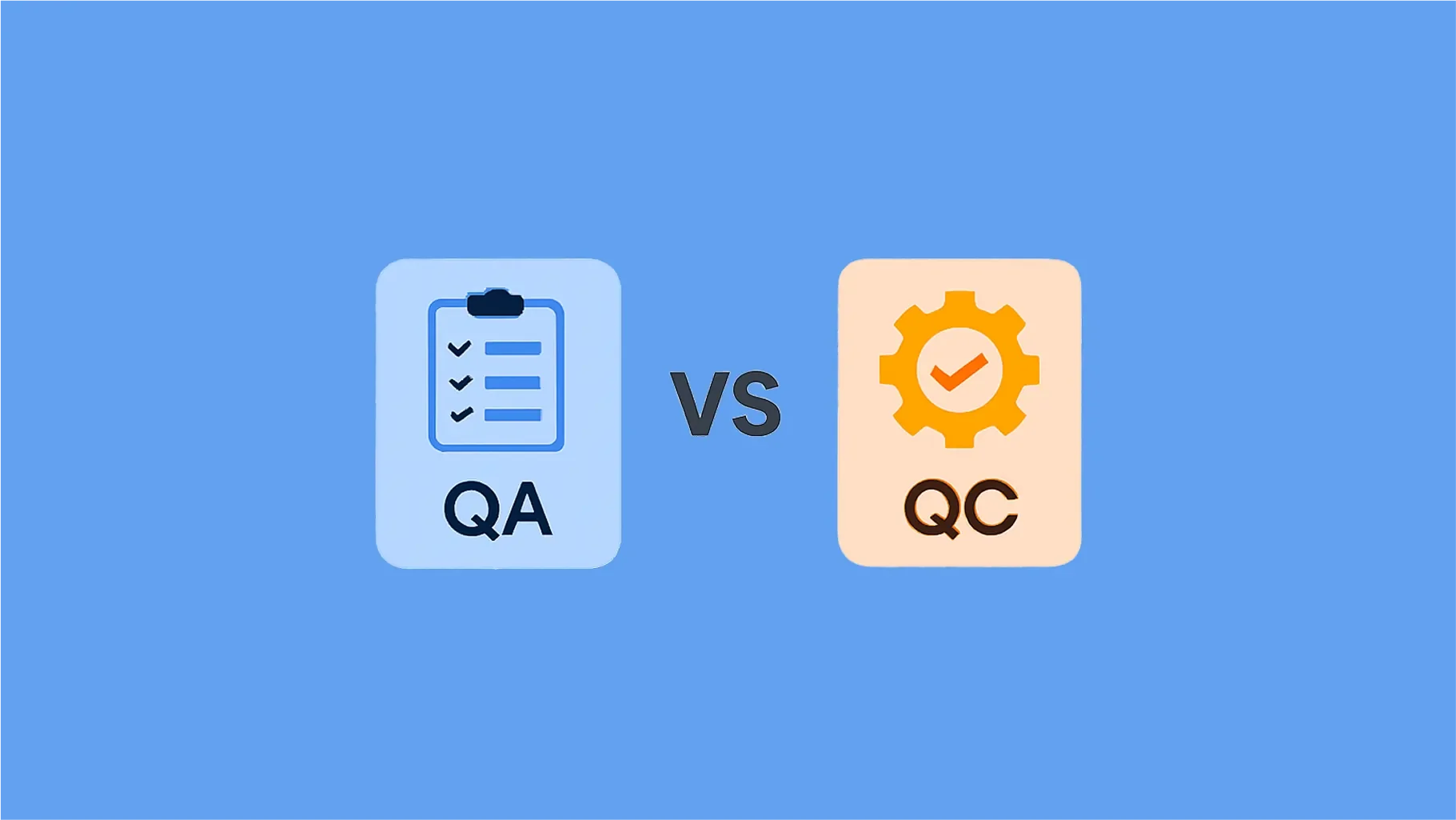Quality Assurance vs Control in Software
Introduction
Software bugs are more than just annoyances; they can be business killers. Back in 2012, a single software glitch caused Knight Capital to lose a jaw-dropping $440 million in just 45 minutes. The culprit? A gap in quality control (QC).
Stories like this show why quality assurance (QA) and quality control (QC) matter so much in software development. These two practices often get lumped together, but they actually play very different roles. QA is all about prevention, setting up processes and standards to stop defects before they happen. QC, on the other hand, is about detection, finding and fixing issues once the product is built.
Both QA and QC are equally important. Think of them as two sides of the same coin: QA makes sure you’re building the right way, while QC ensures you’re delivering the right product. When done together, they help teams ship software that’s reliable, high-performing, and user-friendly, while also avoiding costly failures.

Get the Mobile Testing Playbook Used by 800+ QA Teams
Discover 50+ battle-tested strategies to catch critical bugs before production and ship 5-star apps faster.
What is Quality Assurance (QA) in Software Testing?
Quality Assurance (QA) in software testing is a proactive and process-oriented approach that focuses on preventing defects before they happen rather than fixing them later. Instead of waiting until the software is built to check for problems, QA ensures that every step of the development lifecycle is designed to produce quality software.
Think of QA as the “prevention strategy” in software engineering. Just like a factory sets up quality checkpoints during production to avoid defective products leaving the assembly line, QA in software builds strong processes, standards, and practices to avoid defects creeping into the codebase in the first place.
Key Principles of QA
Prevention Over Detection: QA’s role is to stop defects from occurring by improving processes, tools, and team workflows.
Process-Focused: Unlike quality control (QC), which checks the final product, QA ensures that coding standards, design guidelines, and testing frameworks are in place from the start.
Continuous Improvement: QA teams don’t just test software they analyze past issues, refine processes, and make sure future releases are smoother and more reliable.
Shared Responsibility: QA isn’t just the tester’s job. Developers, designers, product managers, and QA engineers all contribute to embedding quality in the lifecycle.
Core QA Activities in Software Development
Creating Documentation & SOPs: QA defines test strategies, coding guidelines, and workflows to set expectations.
Risk Assessments: QA teams identify potential failure points (e.g., payment systems, login flows) before development starts.
Team Training: Developers and testers are trained on best practices such as unit testing, code reviews, and security checks.
Audits & Process Refinement: QA continuously audits code quality, testing efficiency, and delivery pipelines to spot inefficiencies.
Tooling & Automation Support: QA helps set up CI/CD pipelines, static analysis tools, and test frameworks so quality is automated where possible.
Benefits of QA in Software Testing
Lower Development Costs: Catching defects early is far cheaper than fixing bugs after release.
Faster Release Cycles: With standardized processes and automation, QA reduces rework and accelerates delivery.
Improved User Experience (UX): By preventing usability and performance issues early, QA ensures smoother digital experiences.
Higher Team Productivity: QA eliminates repetitive errors and streamlines collaboration across teams.
Regulatory & Security Compliance: QA ensures adherence to industry standards like ISO, GDPR, HIPAA, or WCAG where required.
Example of QA in Action
Let’s say a fintech app is under development. During the QA process setup, teams define coding best practices, security checks for payment gateways, and test automation frameworks for regression. Because of QA, potential issues such as API inconsistencies or data validation gaps are identified early in design long before they could cause financial errors in production.
In short, quality assurance is about building the right product the right way from the very beginning. It lays the foundation for quality control (QC) to validate the end product later.
What is Quality Control (QC)?
Quality Control (QC) in software testing is a reactive, product-focused approach that ensures the final software product meets defined quality standards and works as expected. Unlike Quality Assurance (QA), which prevents defects by refining processes, QC focuses on detecting and fixing defects after the software is built.
Think of QC as the inspection stage of software development. Just as manufactured goods are inspected before being shipped to customers, QC checks whether the software is functional, reliable, and user-friendly before release.
Key Principles of QC
Detection Over Prevention: QC’s main role is to find defects in the final product and ensure they are resolved before deployment.
Product-Focused: While QA is about processes, QC verifies the actual software through testing activities.
Validation of Requirements: QC ensures the software aligns with business needs, functional requirements, and user expectations.
Dedicated Responsibility: QC is often carried out by testers and QA engineers who specialize in executing test cases, reporting bugs, and validating fixes.
Core QC Activities in Software Testing
Functional Testing: Ensuring the software performs its intended features correctly. Example: A login system accepts valid credentials and rejects invalid ones.
Regression Testing: Checking that new updates or features haven’t broken existing functionality.
Performance & Load Testing: Testing response time, scalability, and stability under expected and peak usage.
Compliance Testing: Validating adherence to standards such as GDPR, WCAG, ISO, HIPAA depending on the domain.
Bug Reporting & Tracking: Identifying, logging, and prioritizing defects using tools like Jira, Bugzilla, or Quash.
User Experience Validation: Checking whether the product is intuitive, responsive, and reliable from an end-user perspective.
Benefits of QC in Software Development
Defect Elimination Before Release: Reduces the risk of bugs reaching customers.
Improved User Confidence: High-quality products result in better reviews, retention, and trust.
Compliance & Security Assurance: Ensures the software passes legal, regulatory, and security requirements.
Business Risk Reduction: Minimizes costly production failures like the Knight Capital $440M incident.
Higher Customer Satisfaction: Fixing usability issues improves the overall user experience.
Example of QC in Action
Imagine an e-commerce app that has just completed development. During QC testing, the team runs:
Functional tests to check cart, checkout, and payment workflows.
Regression tests to ensure a new “wishlist” feature hasn’t broken search or login.
Performance tests to verify the site can handle traffic spikes during sales.
Compliance checks to ensure PCI-DSS standards are met for handling credit card transactions.
If any defects are found such as a checkout crash under heavy load QC ensures these issues are fixed before customers use the product.
In short, quality control validates the software product itself, ensuring it works as intended and delivers value to the user. While QA sets the foundation by improving processes, QC serves as the final checkpoint that safeguards the user experience.

Think of QA as designing a strong bridge, while QC is testing the bridge for cracks once it’s built. Both are vital for safety and reliability.
Building a QA + QC Strategy
To achieve software quality excellence, QA and QC should not work in silos. Together, they create a holistic testing framework.
1. Strategic Planning
Define KPIs such as defect density, test coverage, and defect leakage rate.
Use risk-based testing for critical features (e.g., checkout, payments).
Balance manual testing, automation, and exploratory testing.
2. Resource Allocation
Foster cross-functional collaboration between QA, Dev, and Product.
Leverage tools like Jira, TestRail, Selenium, or Quash for test management.
Optimize for coverage, speed, and cost-efficiency.
3. Documentation & Processes
Keep SOPs and test plans updated.
Integrate feedback loops in daily standups and retrospectives.
Ensure defect reports flow back into process improvements.
QA and QC in the Software Development Lifecycle (SDLC)
Development Phase: Embedding Quality Early
Code Reviews & Unit Testing: catch bugs at source.
Static Code Analysis (SonarQube, ESLint): detect vulnerabilities.
Developer-led QA: enforce standards like API consistency & UI guidelines.
Testing Phase: Validating Functionality & Usability
Exploratory Testing: uncover UX issues.
Error Guessing: predict failure points.
Regression & Compliance Testing: ensure stability across versions.
CI/CD Integration: Continuous Quality
Automated Regression Testing: prevents release blockers.
Performance Monitoring (New Relic, Firebase, Sentry): track real-world performance.
Flaky Test Detection & Shift-Left Testing: enable faster feedback loops.
Measuring QA & QC Success
One of the biggest challenges in software testing is knowing whether your QA and QC processes are actually working. It’s not enough to just run tests, you need to measure outcomes and use data to continuously improve. This is where quality metrics and process metrics come into play.
By tracking the right set of metrics, teams can identify bottlenecks, spot recurring issues, and align QA/QC practices with overall business goals like faster releases, higher customer satisfaction, and reduced costs.
Quality Metrics (Product-Focused)
Quality metrics measure the end result of your testing efforts how well the product performs once built and tested. These fall under the QC perspective since they deal with product validation.
Defect Density (bugs per KLOC): The number of confirmed defects per 1,000 lines of code. A high defect density often points to poor coding practices or insufficient QA processes.
Mean Time to Detect & Fix Bugs (MTTR): Measures how quickly your team can identify and resolve issues. Shorter MTTR = faster releases and happier customers.
User Satisfaction Scores (CSAT, NPS): Direct feedback from users helps validate whether your product actually meets expectations. Even if technical defects are low, poor usability can sink satisfaction scores.
Test Coverage Percentage: Shows how much of the application is covered by test cases (manual + automated). Higher coverage means fewer blind spots where bugs could hide.
Takeaway: Quality metrics answer the question, “Is the product good enough for users?”
Process Metrics (Workflow-Focused)
Process metrics evaluate the effectiveness of QA activities and team workflows. These align more with the QA perspective, since they deal with prevention and process maturity.
Testing Cycle Time: Measures how long each testing phase takes within a release cycle. If testing consistently drags, automation or better planning might be needed.
Defect Leakage Rate: The percentage of defects that escape QA into production. A high leakage rate means your QA processes need refinement.
Test Case Reusability: Tracks how often existing test cases can be reused across projects or releases. Higher reusability indicates mature, efficient processes.
Cross-Team Collaboration Quality: Measures how effectively QA, Dev, and Product teams share knowledge and resolve issues. Can be tracked through retrospectives or collaboration tools (e.g., Jira, Slack reports).
Takeaway: Process metrics answer the question, “Are we building and testing in the most efficient way possible?”
Why Measuring Both Matters
Tracking only one side gives you an incomplete picture. For example:
If your quality metrics look good (low bugs, high coverage) but process metrics are weak (long cycles, poor collaboration), you’ll struggle to scale.
If process metrics are solid but quality metrics lag (high defect leakage, poor user scores), your processes aren’t translating into real-world results.
The sweet spot lies in balancing QA and QC metrics together.
When measured consistently, these metrics:
Provide data-driven insights for improvement.
Help teams prioritize testing efforts around high-risk areas.
Ensure QA and QC stay aligned with business goals, not just technical outcomes.
Drive faster, more reliable software delivery.
Real-World Examples
Theory is great, but nothing drives the point home like real-world QA/QC success and failure stories.
Success Story: Google’s Mobile Testing Transformation Google faced a huge challenge in scaling its mobile testing across Android and iOS devices. By adopting a QA-first mindset standardizing processes, automating test suites, and embedding quality into the CI/CD pipeline Google empowered its QC efforts to catch defects faster. The result? A 40% reduction in release cycles, faster feature rollouts, and a stronger end-user experience. This shows how QA and QC together can deliver real business impact.
Failure Story: Knight Capital’s $440 Million Loss In contrast, Knight Capital’s infamous software disaster in 2012 highlights the cost of weak QC. A deployment error left outdated code running in production, which caused stock trades to spiral out of control. The company lost $440 million in under an hour and never recovered. This serves as a painful reminder that skipping thorough QC checks like regression testing and validation can cripple even the biggest firms.
The lesson? QA prevents issues, QC catches what slips through, and both are non-negotiable for software success.
Future Trends in QA and QC
The world of QA and QC is evolving rapidly with the rise of AI, DevOps, and continuous delivery. Here are the key trends shaping the future:
AI in Testing AI-powered platforms like Testim, Autify, and Quash help generate, maintain, and prioritize test cases automatically. By analyzing code changes and past defect data, they predict where issues are most likely to occur saving testers countless hours.
Self-Healing Tests Traditional automation scripts break whenever the UI changes. Self-healing automation solves this problem by automatically adapting to new layouts, IDs, or workflows dramatically improving test stability and reducing maintenance overhead.
Shift-Left Testing Instead of waiting until later stages, testing is pushed earlier (“left”) in the SDLC. This means unit testing, peer reviews, and static analysis happen alongside development, allowing QA and QC to identify issues before they snowball into production defects.
Visual Regression Testing UI is often the first thing users notice, and even a single pixel shift can cause usability issues. Visual regression tools automatically compare UI snapshots across versions to catch layout, alignment, or styling bugs that functional tests might miss.
These trends show that the future of QA and QC lies in automation, intelligence, and early integration helping teams move faster without sacrificing quality.
Getting Started with QA + QC
If you’re wondering how to put QA and QC into practice, here’s a simple roadmap:
Define Quality KPIs: Start with clear metrics like defect density, defect leakage, and user satisfaction scores aligned to your business goals.
Conduct a QA/QC Process Audit: Review your current workflows to find gaps (e.g., lack of automation, weak regression testing, or poor documentation).
Select the Right Tools: Use test management and automation tools like Jira, Selenium, TestRail, or Quash to streamline collaboration and execution.
Adopt Shift-Left Testing: Encourage developers to run unit tests, code reviews, and static analysis early in development to embed quality from the start.
Monitor Post-Deployment Performance: Use monitoring tools like Sentry, Firebase, or New Relic to track crashes, performance drops, or user issues in production.
Following this roadmap ensures QA and QC are not afterthoughts, but core parts of your development lifecycle.
Final Thoughts
Understanding the difference between QA and QC is essential for any software team aiming to deliver high-quality products.
QA builds quality into the process: making sure development workflows are efficient, standardized, and defect-resistant.
QC validates quality in the product: ensuring the final release works as intended and delivers value to users.
When combined, QA and QC create a complete quality ecosystem that:
Reduces defects and rework
Speeds up release cycles
Saves costs by catching issues early
Boosts user confidence and trust
Ready to take your QA and QC strategy to the next level? Explore Quash, our AI-powered mobile testing platform. With intelligent test generation, automation-first QC, and real-time insights, Quash helps teams ship faster, smarter, and more reliable software.





